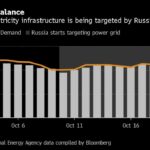
HONG KONG — Chinese President Xi Jinping is set to obtain a historic third term in power as the twice-a-decade congress of his ruling Chinese Communist Party wraps up this weekend. Here’s a look at how the country has changed under his decadelong rule:
Surging growth
The economy has experienced strong growth in recent years, with an average increase in annual gross domestic product of almost 7% from 2013 to 2019. Since Xi took power in 2012, the country’s GDP has more than doubled, from $8.53 trillion to $17.73 trillion.
Much of that growth was based on manufacturing, turning China into the world’s second-largest economy after the United States since 2010. But its leaders are trying to transition toward services and a more consumption-driven economy.
Economic headwinds
A property sector crisis, tightening regulations and a strict “zero-Covid” policy forcing millions into lockdowns have buffeted the economy, spurring unemployment. Officials had set a target of 5.5% growth for this year, but have stopped talking about it after the economy narrowly avoided contraction in the second quarter.
Unemployment is an especially big concern among fresh university graduates, millions of whom enter the job market each year.
The economy has also suffered from the government’s regulatory crackdown on tech companies such as Alibaba and Tencent, which has wiped billions from their market values.
Military modernization
Xi has embarked on an ambitious campaign to modernize and strengthen the military, growing its number of aircraft carriers from one to three — compared with America’s 11 — and opening its first overseas base in the East African country of Djibouti. China’s annual defense spending has more than doubled since 2012 to $230 billion, compared with about $800 billion in the U.S.
He called for even faster military development in his speech opening the party congress in Beijing on Sunday.
“We will enhance the military’s strategic capabilities for defending China’s sovereignty, security and development interests and see that the people’s armed forces effectively fulfill their missions and tasks in the new era,” Xi said.
Tensions with the U.S.
Americans’ views of China have generally declined, particularly among Republicans, as relations have been strained by issues including the status of Taiwan, China’s growing relationship with Russia, the coronavirus pandemic and a trade war that began under then-President Donald Trump. U.S.-China relations are widely considered to be at their lowest point since the two countries established diplomatic ties in 1979.
Progress on poverty
China is credited with lifting about 800 million people out of extreme poverty in the last 40 years, accounting for three-quarters of the reduction in extreme poverty globally, according to the World Bank.
The government attributes 100 million of them to Xi, who made poverty alleviation one of his signature initiatives. Last February, he proclaimed that he had eliminated extreme poverty altogether, though experts have questioned how China defines it.
Despite the undeniable advances, rural residents still have less access to education and health care, while the wealth gap continues to widen.
A looming demographic crisis
As development has increased life expectancy in the country, it has also helped turn it into one of the fastest-aging societies in the world, with the proportion of the population over 60 expected to reach 28% by 2040, according to the World Health Organization.
China tried to address the problem by ending its strict one-child policy in 2016, then further easing measures to allow couples to have up to three children. But many Chinese people express reluctance to grow their families, citing the high cost of raising children and inadequate support for new parents. Last year, the country recorded 10.6 million births, down from 12 million in 2020.
Hannah Lee, Kriti Gandhi and Dorothy Kam contributed.




